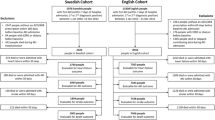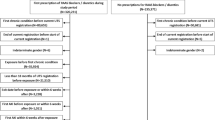Abstract
Purpose
Acute kidney injury (AKI) is associated with the activation of the renin–angiotensin system. Whether angiotensin-converting enzyme inhibitors (ACEi) or angiotensin-receptor blockers (ARB) improve outcome in patients recovering from AKI remains unexplored. The purpose was to investigate the association between prescription of ACEi/ARB at intensive care unit (ICU) discharge and 1-year outcome in patients recovering from AKI.
Methods
Association between ACEi/ARB and 1-year mortality rate was explored in 1551 patients discharged from 21 European ICUs in an observational cohort. One-year all-cause mortality after ICU discharge was the primary endpoint. AKI was defined using the kidney disease improvement global outcome definition. Propensity score matching was used to consider the probability to receive ACEi/ARB at ICU discharge and included chronic heart failure, ACEi/ARB on ICU admission, Charlson Comorbidity Index, age, diabetes mellitus, chronic kidney disease, estimated glomerular filtration rate and arterial blood pressure at ICU discharge vasopressors and renal replacement therapy.
Results
Overall, 1-year mortality was 28 and 15% in patients with AKI (n = 611, 39%) and without AKI (n = 940), respectively. In patients with AKI, unadjusted, adjusted and propensity-score matched 1-year mortality rates were lower in patients treated with ACEi/ARB at ICU discharge [HR of 0.55 (0.35–0.89), HR of 0.45 (0.27–0.75), and HR of 0.48 (0.27–0.85, p < 0.001), respectively]. These results were consistent across sensitivity analysis. No association was observed in patients without AKI.
Conclusions
In patients discharged alive from the ICU after experiencing AKI, ACEi/ARB prescription at discharge is associated with a decrease in 1-year mortality.
Trial registration
ClinicalTrials.gov NCT01367093. Registered on 6 June 2011.



Similar content being viewed by others
References
Cheng S-Y, Chou Y-H, Liao F-L et al (2016) Losartan reduces ensuing chronic kidney disease and mortality after acute kidney injury. Sci Rep 6:34265. https://doi.org/10.1038/srep34265
Efrati S, Berman S, Hamad RA et al (2012) Effect of captopril treatment on recuperation from ischemia/reperfusion-induced acute renal injury. Nephrol Dial Transplant 27:136–145. https://doi.org/10.1093/ndt/gfr256
Burrell LM, Burchill L, Dean RG et al (2012) Chronic kidney disease: cardiac and renal angiotensin-converting enzyme (ACE) 2 expression in rats after subtotal nephrectomy and the effect of ACE inhibition. Exp Physiol 97:477–485. https://doi.org/10.1113/expphysiol.2011.063156
Chou Y-H, Huang T-M, Pan S-Y et al (2017) Renin-angiotensin system inhibitor is associated with lower risk of ensuing chronic kidney disease after functional recovery from acute kidney injury. Sci Rep 7:46518. https://doi.org/10.1038/srep46518
Horkan CM, Purtle SW, Mendu ML et al (2015) The association of acute kidney injury in the critically ill and postdischarge outcomes: a cohort study. Crit Care Med 43:354–364. https://doi.org/10.1097/CCM.0000000000000706
Parr SK, Matheny ME, Abdel-Kader K et al (2017) Acute kidney injury is a risk factor for subsequent proteinuria. Kidney Int. https://doi.org/10.1016/j.kint.2017.07.007
Sawhney S, Marks A, Fluck N et al (2017) Acute kidney injury as an independent risk factor for unplanned 90-day hospital readmissions. BMC Nephrol 18:9. https://doi.org/10.1186/s12882-016-0430-4
Rana I, Velkoska E, Patel SK et al (2015) MicroRNAs mediate the cardioprotective effect of angiotensin-converting enzyme inhibition in acute kidney injury. Am J Physiol Renal Physiol 309:F943–F954. https://doi.org/10.1152/ajprenal.00183.2015
Evans M, Carrero J-J, Szummer K et al (2016) Angiotensin-converting enzyme inhibitors and angiotensin receptor blockers in myocardial infarction patients with renal dysfunction. J Am Coll Cardiol 67:1687–1697. https://doi.org/10.1016/j.jacc.2016.01.050
Burchill L, Velkoska E, Dean RG et al (2008) Acute kidney injury in the rat causes cardiac remodelling and increases angiotensin-converting enzyme 2 expression. Exp Physiol 93:622–630. https://doi.org/10.1113/expphysiol.2007.040386
Joannidis M, Druml W, Forni LG et al (2017) Prevention of acute kidney injury and protection of renal function in the intensive care unit: update 2017: expert opinion of the Working Group on Prevention, AKI section, European Society of Intensive Care Medicine. Intensive Care Med 43:730–749. https://doi.org/10.1007/s00134-017-4832-y
Cheungpasitporn W, Thongprayoon C, Srivali N et al (2015) Preoperative renin-angiotensin system inhibitors use linked to reduced acute kidney injury: a systematic review and meta-analysis. Nephrol Dial Transplant 30:978–988. https://doi.org/10.1093/ndt/gfv023
Gayat E, Cariou A, Deye N et al (2018) Determinants of long-term outcome in ICU survivors: results from the FROG-ICU study. Crit Care Lond Engl 22:8. https://doi.org/10.1186/s13054-017-1922-8
Mebazaa A, Casadio MC, Azoulay E et al (2015) Post-ICU discharge and outcome: rationale and methods of the The French and euRopean Outcome reGistry in Intensive Care Units (FROG-ICU) observational study. BMC Anesthesiol 15:143. https://doi.org/10.1186/s12871-015-0129-2
Hoste EAJ, Bagshaw SM, Bellomo R et al (2015) Epidemiology of acute kidney injury in critically ill patients: the multinational AKI-EPI study. Intensive Care Med 41:1411–1423. https://doi.org/10.1007/s00134-015-3934-7
Forni LG, Darmon M, Ostermann M et al (2017) Renal recovery after acute kidney injury. Intensive Care Med 43:855–866. https://doi.org/10.1007/s00134-017-4809-x
Grambsch P, Therneau T (1994) Proportional hazards tests and diagnostics based on weighted residuals. Biometrika 81:515–526
Harrell FE, Lee KL, Mark DB (1996) Multivariable prognostic models: issues in developing models, evaluating assumptions and adequacy, and measuring and reducing errors. Stat Med 15:361–387. https://doi.org/10.1002/(SICI)1097-0258(19960229)15:4%3c361:AID-SIM168%3e3.0.CO;2-4
Prescott HC, Angus DC (2018) Enhancing recovery from sepsis: a review. JAMA 319:62–75. https://doi.org/10.1001/jama.2017.17687
Dépret F, Prud’homme M, Legrand M (2017) A role of remote organs effect in acute kidney injury outcome. Nephron 137:273–276. https://doi.org/10.1159/000476077
Simões E, Silva AC, Teixeira MM (2016) ACE inhibition, ACE2 and angiotensin-(1-7) axis in kidney and cardiac inflammation and fibrosis. Pharmacol Res 107:154–162. https://doi.org/10.1016/j.phrs.2016.03.018
Zhong J, Basu R, Guo D et al (2010) Angiotensin-converting enzyme 2 suppresses pathological hypertrophy, myocardial fibrosis, and cardiac dysfunction. Circulation 122:717–728. https://doi.org/10.1161/circulationaha.110.955369 (18 p following 728)
Whelton PK, Carey RM, Aronow WS et al (2017) 2017 ACC/AHA/AAPA/ABC/ACPM/AGS/APhA/ASH/ASPC/NMA/PCNA guideline for the prevention, detection, evaluation, and management of high blood pressure in adults: a report of the American College of Cardiology/American Heart Association task force on clinical practice guidelines. Hypertens Dallas Tex. https://doi.org/10.1161/HYP.0000000000000065
Chawla LS, Eggers PW, Star RA, Kimmel PL (2014) Acute kidney injury and chronic kidney disease as interconnected syndromes. N Engl J Med 371:58–66. https://doi.org/10.1056/NEJMra1214243
Acknowledgements
The authors are particularly grateful to CRAs and healthcare providers of all the investigating centers. We also thank the Centre de Recherche Clinique (CRC) of Lariboisière University Hospital for his support.
Funding
FROG-ICU was funded by the Programme Hospitalier de la Recherche Clinique (AON 10-216) and by a research grant from the Société Française d’Anesthésie—Réanimation.
Author information
Authors and Affiliations
Consortia
Contributions
Study concept and design: Gayat, Legrand, Mebazaa; Acquisition of data: Gayat, Mebazaa, Vieillard-Baron, Cariou, Deye, Jaber, Chousterman, Lu, Laterre, Monnet, Leone, Guidet, Lefrant, Fournier, Legrand; Analysis and interpretation of data: Gayat, Legrand, Mebazaa; Drafting of the manuscript: Legrand, Gayat, Hollinger, Mebazaa; Critical revision of the manuscript for important intellectual content: all declared authors; Statistical analysis: Gayat; Obtained funding: Gayat, Mebazaa; Administrative, technical, or material support: Gayat, Mebazaa, Fournier; Study supervision: Gayat, Legrand, Mebazaa; All authors have read and approved the final manuscript.
Corresponding author
Ethics declarations
Conflicts of interest
EG received research grants from Sphingotec, and consultancy fees from Magnisense and Roche Diagnostics. AM received speaker’s honoraria from Abbott, Novartis, Orion, Roche and Servier, and fees as a member of the advisory board and/or Steering Committee from Cardiorentis, Adrenomed, MyCartis, Neurotronik and Sphyngotec. ML received research grants from Sphingotec, consultancy fees from Astellas and Lecture fees from Gilead and Fresenius. The remaining authors declare that they have no competing interests.
Electronic supplementary material
Below is the link to the electronic supplementary material.
134_2018_5160_MOESM1_ESM.tiff
eFigure 1. Imbalance before (black square) and after (red bullet) propensity score matching for variables included in the propensity model with patients who developed AKI during ICU stay (TIFF 61 kb)
134_2018_5160_MOESM2_ESM.tiff
eFigure 2. Survival curves according to prescription of ACEi at ICU discharge in patients without AKI (Panel A) and Imbalance before (black square) and after (red bullet) propensity score matching for variables included in the propensity model with patients who didn’t developed AKI during ICU stay(Panel B) (TIFF 220 kb)
Rights and permissions
About this article
Cite this article
Gayat, E., Hollinger, A., Cariou, A. et al. Impact of angiotensin-converting enzyme inhibitors or receptor blockers on post-ICU discharge outcome in patients with acute kidney injury. Intensive Care Med 44, 598–605 (2018). https://doi.org/10.1007/s00134-018-5160-6
Received:
Accepted:
Published:
Issue Date:
DOI: https://doi.org/10.1007/s00134-018-5160-6




